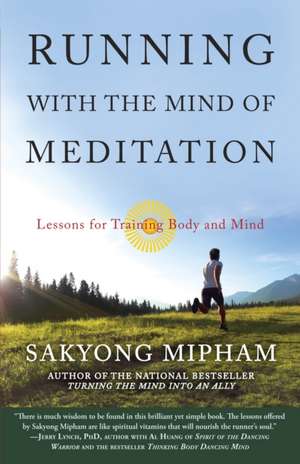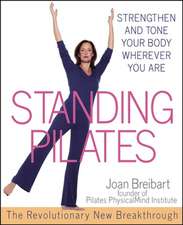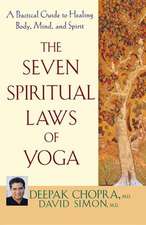Running with the Mind of Meditation
Autor Sakyong Mipham, Rinpocheen Limba Engleză Paperback – 14 apr 2013
As a Tibetan lama and leader of Shambhala (an international community of 165 meditation centers), Sakyong Mipham has found physical activity to be essential for spiritual well-being. He's been trained in horsemanship and martial arts but has a special love for running. Here he incorporates his spiritual practice with running, presenting basic meditation instruction and fundamental principles he has developed. Even though both activities can be complicated, the lessons here are simple and designed to show how the melding of internal practice with physical movement can be used by anyone - regardless of age, spiritual background, or ability - to benefit body and soul.
From the Hardcover edition.
Preț: 67.14 lei
Preț vechi: 81.33 lei
-17% Nou
Puncte Express: 101
Preț estimativ în valută:
12.85€ • 13.95$ • 10.79£
12.85€ • 13.95$ • 10.79£
Carte disponibilă
Livrare economică 01-08 aprilie
Livrare express 15-21 martie pentru 31.48 lei
Preluare comenzi: 021 569.72.76
Specificații
ISBN-13: 9780307888174
ISBN-10: 0307888177
Pagini: 200
Dimensiuni: 131 x 202 x 14 mm
Greutate: 0.18 kg
Editura: Three Rivers Press (CA)
ISBN-10: 0307888177
Pagini: 200
Dimensiuni: 131 x 202 x 14 mm
Greutate: 0.18 kg
Editura: Three Rivers Press (CA)
Notă biografică
SAKYONG MIPHAM is the leader of Shambhala, a worldwide network of meditation and retreat centers. He's also an avid marathon runner and golfer, he frequently retreats to study at a Tibetan monastery in India, and he writes a regular column in the Shambhala Sun. The author of the bestselling titles Ruling Your World and Turning the Mind Into an Ally, Sakyong Mipham was named one of the thirty global visionaries of our time by Planet magazine. He spends his time teaching all over the world, using his unique blend of Eastern and Western perspectives to the benefit of his students in North and South America, Europe, and Asia.
Extras
9780307888167|excerpt
Rinpoche / RUNNING WITH THE MIND OF MEDITATION
1
Running with the Mind of Meditation
We woke up early to sneak out of the monastery and get our morning run in before the ceremonies began. We drove to a nearby reservoir, got out, and began to stretch. It was only three thirty, and the early morning Indian mist and the coolness of the night still hung in the air. We were all a little nervous and excited, as we were running a new route.
We slid down an embankment, found the trailhead, and began to run, mostly at a slow jog—with the reservoir on one side and open grasslands bordering a teak forest on the other. Even though none of us had slept very much the night before, we felt very awake. As we ran through the grassy country- side, Josh Silberstein, my assistant, said to me, “Is there anything we should be watching out for, Rinpoche?” I quickly replied, “Yeah—cobras, leopards, wild elephants, and, oh, the occasional pack of wild dogs.” Josh laughed and asked, “No, really, what should we be watching out for?” Looking at my face, he said, “Oh, you’re not joking.” “Not about that,” I replied. At that moment, the nature of the run changed for him.
We ran through meterwide sinkholes and large mounds of dirt, which we soon realized were elephant tracks and dung piles. We came across wide-open expanses that reminded me of the African savanna. The trail then headed into the forest, lush and thick, part of what remains of the great teak forest that used to cover most of the subcontinent. Occasionally we would see someone walking along, carrying a basket.
The rhythmic movement of our feet created ease and relaxation in our bodies, revitalized by the fresh air. We remained alert and constantly aware of our environment, which helped us to be present in the moment. Even though we weren’t saying much, there existed between us the camaraderie of an unspoken language, a deep feeling of appreciation that we were alive and healthy. We felt fortunate to be able to run. This was no ordinary run: we were training for the Boston Marathon, only two months away. Luckily we did not encounter too many wild animals while enjoying the Indian wilderness.
As the sun rose, we returned to Mysore, in southern India, to Namdroling Monastery, where I have spent much time meditating and studying Buddhist philosophy. On this stay, I was visiting my spiritual teacher, His Holiness Penor Rinpoche, to receive teachings and empowerments. Rinpoche, the Tibetan honori- fic for high lamas, means “precious jewel.” In the Tibetan Buddhist tradition, before engaging on a spiritual path or beginning meditation, one needs to first receive authorization and transmission from a teacher. This keeps the spiritual lineage pure. In this case, I was receiving transmissions of the Mipham lineage. I am considered to be the rebirth of Tibet’s Mipham the Great (1846ߝ1912), one of the most revered teachers that Tibet has produced.
I have always found a natural relationship between running and meditation. Running can be a support for meditation, and meditation can be a support for running. Running is a natural form of exercise, for it is simply an extension of walking. When we run, we strengthen our heart, remove stagnant air, revitalize our nervous system, and increase our aerobic capacity. It helps us develop a positive attitude. It creates exertion and stamina and gives us a way to deal with pain. It helps us relax. For many of us, it offers a feeling of freedom. Likewise, meditation is a natural exercise of the mind—an opportunity to strengthen, reinvigorate, and cleanse. Through meditation we can connect with that long-forgotten goodness we all have. It is very powerful to feel that sense of goodness: having confidence and bravery in our innermost being.
Just as in running, in meditation we leave behind our daily concerns—the daydreaming, stress, and planning. We become very present. We enter into the now. By doing that, our mind builds strength. Our nervous system begins to relax. We develop appreciation and awareness. Our intelligence and memory become sharper. We are able to see the world from more than one perspective. We are no longer imprisoned by emotional highs and lows. Love, compassion, and other positive qualities become more easily accessible. Just as in running, when we finish meditating, we feel refreshed, and much for the same reason: meditation is a natural, healthy activity.
People sometimes say, “Running is my meditation.” Even though I know what they mean, in reality, running is running and meditation is meditation. That’s why they have different names. It would be just as inaccurate to say, “Meditation is my exercise.” I have known some advanced meditators who have been able to bring their meditative mind—that strength and relaxation—into their body with its channels, nervous system, and muscles. They become strong, radiant, and resilient. We even have a type of meditation in Tibet called heat meditation, in which yogis who are able to use the power of their mind to control their body heat meditate in subzero conditions for months, wearing only a cotton shawl. However, it is unlikely that they would be able to run a sub-three-hour marathon.
Likewise, it is unlikely that we are going to attain enlightenment by running, even though some have tried. It is not a matter of choosing what is better—exercising the mind or exercising the body. Rather, these activities go hand in hand. We need to exercise both our body and our mind. The nature of the body is form and substance. The nature of the mind is consciousness. Because the body and mind are different by nature, what benefits them is different in nature as well. The body benefits from movement, and the mind benefits from stillness. When we give our mind and body what benefits them, a natural harmony and balance take place. With this unified approach, we are happy, healthy, and wise.
Even in the ancient world, it was understood that people are happier when their minds are flexible and their bodies are strong. In the modern world, we are faced with conditions that challenge this mental and physical balance. We sleep less now, so we are often tired. We end up sitting down a great deal, riding in cars or buses in order to work in ill-designed chairs that give us back problems and bad circulation. The quality of the air in our environment may be poor, so we become even tighter and more tired.
Often we are stressed from the moment we wake up. The alarm clock goes off—hardly a substitute for the sun gently rising. E-mailing, texting, working on the computer, and watching television can be draining. Many of us rarely have full or complete conversations because we don’t have time. Even our food is constantly being manipulated.
Both physically and mentally, we are taking on a great load. In order to handle that load, we need to attend to our well-being. Because the mind and the body are intimately connected, relieving the stress of the body through exercise has an immediate effect on the mind: the mind is no longer dealing with the discomfort of the body. If the body is relaxed and flexible, that is one less thing for the mind to think about. The physical act of running thus provides some mental relief, especially the greater the distance run.
In teaching my first meditation and running workshop, I was struck by the number of participants who were ultra- marathon runners. When I considered their experience, it made sense. After you run for a while, what do you find in there but your own mind? You work with that mind by meditating regularly.
Running works with the periphery or the superficial level of thoughts, concerns, and worries. Meditation not only deals with the periphery, it goes all the way down to the core. The path of meditation can be used in simple and immediate ways. It will help you recover from a stressful day or clear your mind before making an important decision. Or it can further your understanding of the nature of reality—all the way to enlightenment.
Rinpoche / RUNNING WITH THE MIND OF MEDITATION
1
Running with the Mind of Meditation
We woke up early to sneak out of the monastery and get our morning run in before the ceremonies began. We drove to a nearby reservoir, got out, and began to stretch. It was only three thirty, and the early morning Indian mist and the coolness of the night still hung in the air. We were all a little nervous and excited, as we were running a new route.
We slid down an embankment, found the trailhead, and began to run, mostly at a slow jog—with the reservoir on one side and open grasslands bordering a teak forest on the other. Even though none of us had slept very much the night before, we felt very awake. As we ran through the grassy country- side, Josh Silberstein, my assistant, said to me, “Is there anything we should be watching out for, Rinpoche?” I quickly replied, “Yeah—cobras, leopards, wild elephants, and, oh, the occasional pack of wild dogs.” Josh laughed and asked, “No, really, what should we be watching out for?” Looking at my face, he said, “Oh, you’re not joking.” “Not about that,” I replied. At that moment, the nature of the run changed for him.
We ran through meterwide sinkholes and large mounds of dirt, which we soon realized were elephant tracks and dung piles. We came across wide-open expanses that reminded me of the African savanna. The trail then headed into the forest, lush and thick, part of what remains of the great teak forest that used to cover most of the subcontinent. Occasionally we would see someone walking along, carrying a basket.
The rhythmic movement of our feet created ease and relaxation in our bodies, revitalized by the fresh air. We remained alert and constantly aware of our environment, which helped us to be present in the moment. Even though we weren’t saying much, there existed between us the camaraderie of an unspoken language, a deep feeling of appreciation that we were alive and healthy. We felt fortunate to be able to run. This was no ordinary run: we were training for the Boston Marathon, only two months away. Luckily we did not encounter too many wild animals while enjoying the Indian wilderness.
As the sun rose, we returned to Mysore, in southern India, to Namdroling Monastery, where I have spent much time meditating and studying Buddhist philosophy. On this stay, I was visiting my spiritual teacher, His Holiness Penor Rinpoche, to receive teachings and empowerments. Rinpoche, the Tibetan honori- fic for high lamas, means “precious jewel.” In the Tibetan Buddhist tradition, before engaging on a spiritual path or beginning meditation, one needs to first receive authorization and transmission from a teacher. This keeps the spiritual lineage pure. In this case, I was receiving transmissions of the Mipham lineage. I am considered to be the rebirth of Tibet’s Mipham the Great (1846ߝ1912), one of the most revered teachers that Tibet has produced.
I have always found a natural relationship between running and meditation. Running can be a support for meditation, and meditation can be a support for running. Running is a natural form of exercise, for it is simply an extension of walking. When we run, we strengthen our heart, remove stagnant air, revitalize our nervous system, and increase our aerobic capacity. It helps us develop a positive attitude. It creates exertion and stamina and gives us a way to deal with pain. It helps us relax. For many of us, it offers a feeling of freedom. Likewise, meditation is a natural exercise of the mind—an opportunity to strengthen, reinvigorate, and cleanse. Through meditation we can connect with that long-forgotten goodness we all have. It is very powerful to feel that sense of goodness: having confidence and bravery in our innermost being.
Just as in running, in meditation we leave behind our daily concerns—the daydreaming, stress, and planning. We become very present. We enter into the now. By doing that, our mind builds strength. Our nervous system begins to relax. We develop appreciation and awareness. Our intelligence and memory become sharper. We are able to see the world from more than one perspective. We are no longer imprisoned by emotional highs and lows. Love, compassion, and other positive qualities become more easily accessible. Just as in running, when we finish meditating, we feel refreshed, and much for the same reason: meditation is a natural, healthy activity.
People sometimes say, “Running is my meditation.” Even though I know what they mean, in reality, running is running and meditation is meditation. That’s why they have different names. It would be just as inaccurate to say, “Meditation is my exercise.” I have known some advanced meditators who have been able to bring their meditative mind—that strength and relaxation—into their body with its channels, nervous system, and muscles. They become strong, radiant, and resilient. We even have a type of meditation in Tibet called heat meditation, in which yogis who are able to use the power of their mind to control their body heat meditate in subzero conditions for months, wearing only a cotton shawl. However, it is unlikely that they would be able to run a sub-three-hour marathon.
Likewise, it is unlikely that we are going to attain enlightenment by running, even though some have tried. It is not a matter of choosing what is better—exercising the mind or exercising the body. Rather, these activities go hand in hand. We need to exercise both our body and our mind. The nature of the body is form and substance. The nature of the mind is consciousness. Because the body and mind are different by nature, what benefits them is different in nature as well. The body benefits from movement, and the mind benefits from stillness. When we give our mind and body what benefits them, a natural harmony and balance take place. With this unified approach, we are happy, healthy, and wise.
Even in the ancient world, it was understood that people are happier when their minds are flexible and their bodies are strong. In the modern world, we are faced with conditions that challenge this mental and physical balance. We sleep less now, so we are often tired. We end up sitting down a great deal, riding in cars or buses in order to work in ill-designed chairs that give us back problems and bad circulation. The quality of the air in our environment may be poor, so we become even tighter and more tired.
Often we are stressed from the moment we wake up. The alarm clock goes off—hardly a substitute for the sun gently rising. E-mailing, texting, working on the computer, and watching television can be draining. Many of us rarely have full or complete conversations because we don’t have time. Even our food is constantly being manipulated.
Both physically and mentally, we are taking on a great load. In order to handle that load, we need to attend to our well-being. Because the mind and the body are intimately connected, relieving the stress of the body through exercise has an immediate effect on the mind: the mind is no longer dealing with the discomfort of the body. If the body is relaxed and flexible, that is one less thing for the mind to think about. The physical act of running thus provides some mental relief, especially the greater the distance run.
In teaching my first meditation and running workshop, I was struck by the number of participants who were ultra- marathon runners. When I considered their experience, it made sense. After you run for a while, what do you find in there but your own mind? You work with that mind by meditating regularly.
Running works with the periphery or the superficial level of thoughts, concerns, and worries. Meditation not only deals with the periphery, it goes all the way down to the core. The path of meditation can be used in simple and immediate ways. It will help you recover from a stressful day or clear your mind before making an important decision. Or it can further your understanding of the nature of reality—all the way to enlightenment.
Recenzii
There is much wisdom to be found in this brilliant yet simple book. The lessons offered by Sakyong Mipham are like spiritual vitamins that will nourish the runner's soul.
ߝJerry Lynch, Ph.D, author with Al Huang of Spirit of the Dancing Warrior and the best-seller, Thinking Body, Dancing Mind
Running With the Mind of Meditation is a delightful and welcome addition to contemplative literature. We often forget that movement is a natural complement to meditative practice, and helps us avoid what has been called the 'stone Buddha' syndrome. This book is a profound guide to the integration of mind and body."
-Larry Dossey, MD, author of Healing Words: the Power of Premonitions and The Extraordinary Healing Power of Ordinary Things
ߝJerry Lynch, Ph.D, author with Al Huang of Spirit of the Dancing Warrior and the best-seller, Thinking Body, Dancing Mind
Running With the Mind of Meditation is a delightful and welcome addition to contemplative literature. We often forget that movement is a natural complement to meditative practice, and helps us avoid what has been called the 'stone Buddha' syndrome. This book is a profound guide to the integration of mind and body."
-Larry Dossey, MD, author of Healing Words: the Power of Premonitions and The Extraordinary Healing Power of Ordinary Things
Descriere
A unique fitness program from a highly respected spiritual leader that blends physical and spiritual practice for everyone--regardless of age, spiritual background, or ability--to great benefits for both body and soul.













